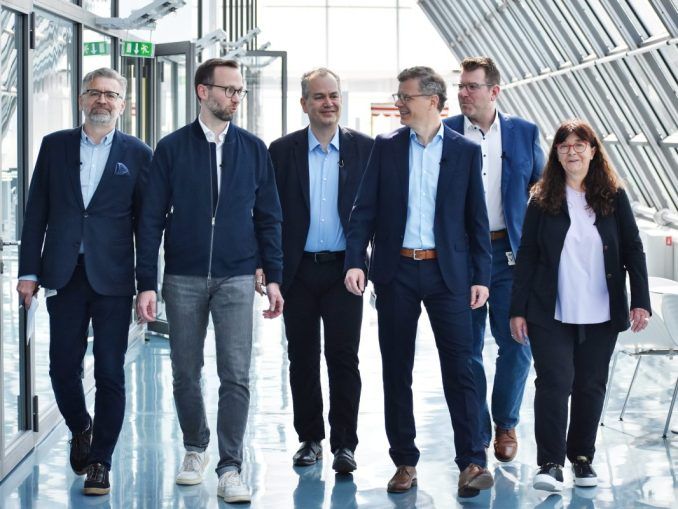The Cloud Journey Deluxe roundtable was a discussion round on the topic of the cloud. It was about the extent to which companies are already using it and how far the journey can still go. It was organized by IT Welt, and several experts from the cloud/IT sector took part.
Who were the participants?
A full five experts gave their views on the cloud and its possibilities at the roundtable. These were:
- Alexander Bruckner (T-Systems Austria)
- Matthias Goetz (IBM)
- Alexander Krauter (proALPHA)
- Alexander Penev (Bytesource Technology)
- Heidrun Walker (Nutanix)

Cloud & digitalization: the status quo
Cloud & digitization: the status quo
But back to the roundtable discussion: First of all, an important question was how companies are doing at the moment with the cloud, but also with digitalization. And the answer?
It's clear that the Corona pandemic has given a strong boost to digitalization in general - at the same time, the technology potential has not yet been exhausted at many companies. So companies still have some opportunities open.
But the pandemic has also made a lot of progress with regard to the cloud in particular: The demand for cloud has increased, whereas this topic used to be rather fearful. The fear came from the question how secure a cloud really is. In the meantime, however, many companies in Austria have taken the prerequisites for the cloud. Now it is important to use the cloud sensibly, says Alexander Bruckner (T-Systems Austria).
If this happens, the cloud is in turn a strong and important factor in the digitalization of companies.
By the way: Partly, the cloud evolution is presented in such a way that a "cloud first" approach has first emerged, while this has now changed into a "cloud only" approach. Here, however, the debate is whether it will really be "cloud only" or rather "cloud first" in the future.
And a little fun fact for anyone interested in marketing: In terms of mobile search (Google searches via smartphone, rather than PC), there was a similar evolution. Again, the "mobile first" approach transitioned to a "mobile only" approach.
Goals entrepreneurs are pursuing with a cloud
First, two fairly obvious goals came up in the roundtable: Boosting innovation and reducing costs. So companies want to use the cloud to strengthen their innovation capabilities while reducing costs.
But there is also a more unusual goal that some businesses want to achieve through the cloud - and that is attractiveness. In fact, many industrial entrepreneurs are finding that IT professionals tend to be drawn to digital-native companies or to startups - and not so much to the IT departments of industrial companies. By using clouds, they therefore want to show that there are also innovation and exciting tasks in industrial companies.
Impact of the cloud
So what impact does a cloud have? Clearly, companies are starting to question their business processes - Alexander Krauter (pro ALPHA) also sees this in his work. And this rethinking of processes brings us back to the innovation mentioned above.
And: Clouds make many innovations possible in the first place. Heidrun Walker (Nutanix), for example, notes that the topic of ChatGPT, which is attracting so much attention at the moment, would not be possible without a private cloud.
The cloud: benefits, threats & sustainability
Let's start with the positive: Clouds offer a number of advantages to many companies. These include the flexibility it brings them and the speed of innovation. These are two big and important points for companies to be competitive.
It should be noted, however, that digitization in general and the cloud in particular always come with certain rules of the game. So you always have to ask yourself here: What is possible at all? What is feasible? Not only technical and organizational aspects play a role here, but also the legislation of the respective country.
But what about the third point? What does a cloud have to do with sustainability? This topic was also addressed by Alexander Penev (Bytesource Technology) at the roundtable. He mentioned it because clouds (hyperscalers) make two things possible:
- Energy tracking
- Measurement of electricity costs For example, companies can see exactly where unnecessary electricity costs are being incurred and where they can make some savings.
The integration of clouds & the challenges along the way
The round also discussed where and how the cloud should be integrated into companies. Many opinions were that it should be integrated with the IT departments. These should then become experts in this area - with support available here in the form of workshops and e-learning.
However, it was also noted that the HR department should also be involved in the integration. After all, cloud integration always involves changes in processes and a certain amount of "upskilling", i.e. building new skills and capabilities. Here, the HR department is important to accompany this process.
Another challenge that should not be forgotten, according to Heidrun Walker, is multicloud management. As the name suggests, this is about handling multiple clouds - because the question is not only how to integrate a cloud into operations, but also how, for example, to...
- migrate data from one cloud to another,
- control costs,
- administer cloud manifestations (private cloud, edge, hyperscalers).
But the good thing about all these challenges is that companies are not alone in facing them - all the experts agree on that.
Are clouds right for everyone?
In general, it can be said - also in the context of the expert round - that not all industries are equally open to clouds. There are some differences that can be observed here.
If a company is generally open to this topic, it is important for the experts to also pay attention to the areas in which the respective companies are open to clouds in the first place.
Matthias Goetz (IBM), for example, notes that a distinction must be made here between the following company areas:
- Front office
- Mid office
- Back Office
Front-office issues, for example, are already almost always used as a cloud service, whereas it is not quite so simple with mid- and back-office. In fact, there are differences here. But the mid- and back-office areas also have one thing in common: here, too, the public cloud is becoming more and more popular.
Conclusion: The cloud as a spectre or a magic lamp?
The conclusion of the discussion round is quickly drawn: The topic of clouds is very complex, with some challenges, important preparations and things to watch out for in this context.
At the same time, it brings many benefits - and not only in terms of innovation and flexibility, but even in terms of unexpected issues such as employer attractiveness.
In any case, the participants in the discussion round have the ambition to bring the topic of cloud more into the consciousness of society. Moreover, they even see the cloud as a standard in the future.
If you want to be part of the cloud journey, we are your competent partner at eye level.
Here you can find the video of the expert round:Cloud Computing Click here to view the original article:
